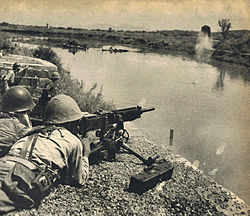Battle of Changsha (1941)
| Battle of Changsha (1941) | |||||||
|---|---|---|---|---|---|---|---|
| Part of the Second Sino-Japanese War of the Pacific War | |||||||
 A Japanese soldier firing a Type 92 Heavy Machine Gun across the Miluo river in September 1941 | |||||||
| |||||||
| Belligerents | |||||||
|
|
| ||||||
| Commanders and leaders | |||||||
|
|
| ||||||
| Strength | |||||||
|
110,000 troops (10 corps) | 120,000+ Army, Navy | ||||||
| Casualties and losses | |||||||
| unknown[1] |
1,670 deaths 5,184 injured 14 MIA[2] | ||||||
The Battle of Changsha (6 September–8 October 1941) was Japan's second attempt at taking the city of Changsha, China, the capital of Hunan Province, as part of the Second Sino-Japanese War.
Overview
The offensive was carried out by more than 120,000 Japanese troops and much better equipment all around, including supporting naval and air forces. The Chinese forces under the command of General Xue Yue—the 9th Army Group—gathered more than 300,000 with help from the 5th,6th,and the 7th Army Groups,except due to poor intelligence on the Japanese invading forces plus its telegraphic messages having been code-broken by the Japanese army such that the defense was on the passive end of the battles. The invading forces got into Changsha city on September 27, 1941. After a major fire which burned down much of the Changsha city, with help from the 6th and the 7th Army Groups, the defensive forces conducted a response that included heavy street fighting in Changsha city. The Chinese armies eventually defended Changsha, retaking the city. Total Chinese casualties amounted to more than 70,000. Then the 5th and the 6th Army Groups attacked the Japanese forces west of Hankou city in Hubei province which caused the Japanese Army to withdraw from Changsha. The Japanese Army was running low on ammunition and food supply while they suffered over 7,000 casualties (killed, wounded and missing) and retreated.
Course of battle
The battle started when a small Chinese guerrilla force clashed with the Japanese 6th Division in the mountains southeast of Yueyang on 6 September. On the 17th, the Japanese crossed the Xinqiang River (新墙河) at four points and made rapid advances, crossing the Miluo River on 19 September. The main Chinese force avoided confronting the enemy but marched in a parallel fashion, out-flanking the Japanese trail southward. The Japanese also attempted to out-flank and encircle the Chinese. This caused both the Chinese and the Japanese armies to reach the Laotao River (捞刀河) regions for an inevitable battle.
On 27 September, several hundred Japanese troops in plain clothes reached the north gate of Changsha but were unable to sabotage the city defenses, leading to heavy fighting on the 28th. Unable to overcome the defenders, the Japanese began a general retreat back to the Yueyang region on 30 September.
References
Sources
- [1] Hsu Long-hsuen and Chang Ming-kai, History of The Sino-Japanese War (1937–1945) 2nd Ed.,1971. Translated by Wen Ha-hsiung, Chung Wu Publishing; 33, 140th Lane, Tung-hwa Street, Taipei, Taiwan Republic of China.
28°12′00″N 112°58′01″E / 28.2000°N 112.9670°E
